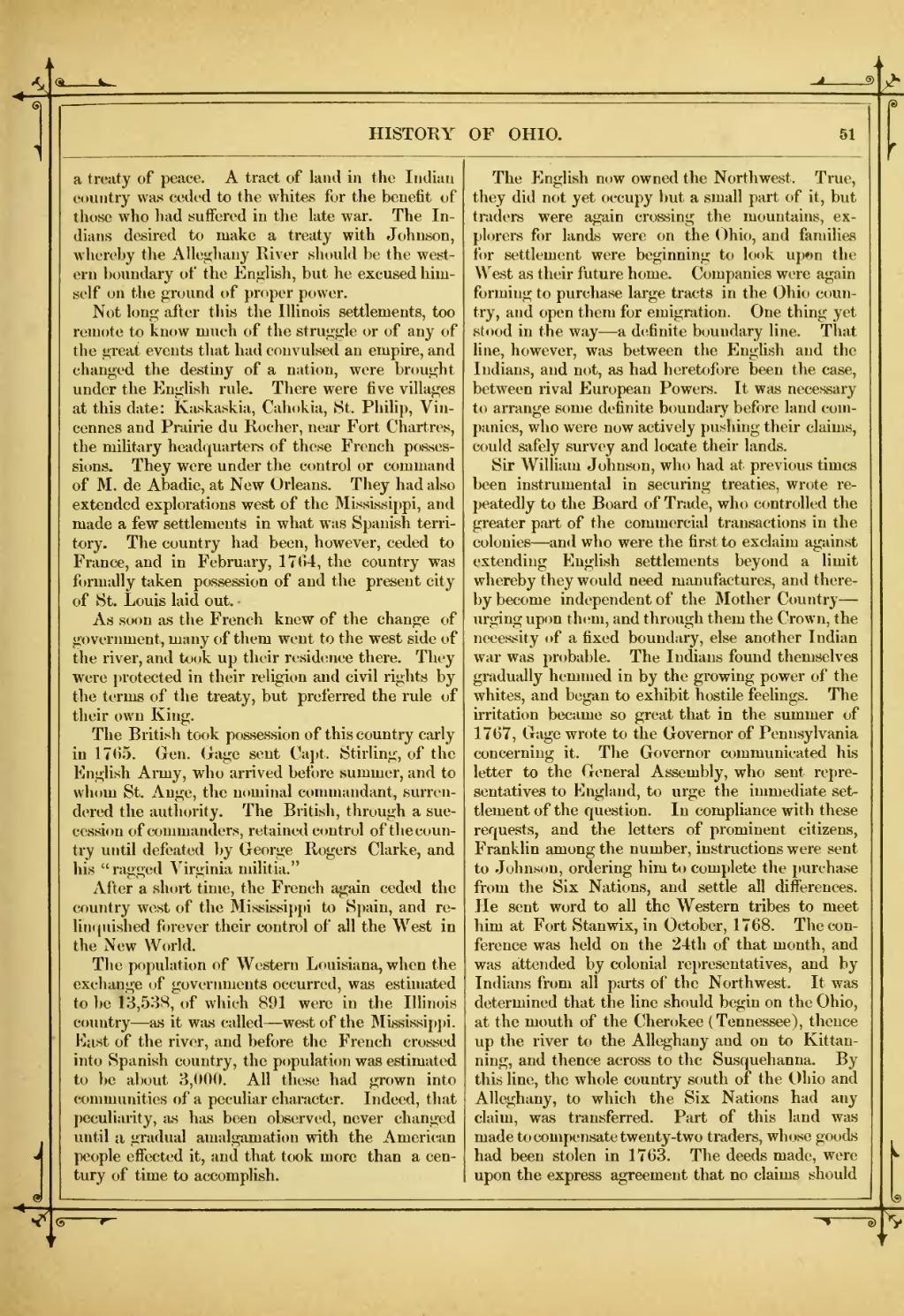HISTOEY OF OHIO.
��51
��a treaty of peace. A tract of land in the Indian country was ceded to the whites for the benefit of those who had suifered in the late war. The In- dians desired to make a treaty with Johnson, whereby the Alleghany River should be the west- ern boundary of the English, but he excused him- self on the ground of proper power.
Not long after this the Illinois settlements, too remote to know much of the struggle or of any of the great events that had convulsed an empire, and changed the destiny of a nation, were brought under the English rule. There were five villages at this date: Kaskaskia, Cahokia, St. Philip, Vin- cennes and Prairie du Rocher, near Fort Chartres, the mihtary headquarters of these French posses- sions. They were under the control or command of M. de Abadie, at New Orleans. They had also extended explorations west of the Mississippi, and made a few settlements in what was Spanish terri- tory. The country had been, however, ceded to France, and in February, 1764, the country was formally taken possession of and the present city of St. Louis laid out. -
As soon as the French knew of the change of government, many of them went to the west side of the river, and took up their residence there. They were protected in their religion and civil rights by the terms of the treaty, but preferred the rule of their own King.
The British took possession of this country early in 1765. Grcn. Gage sent Capt. Stirling, of the English Army, who arrived before summer, and to whom St. Ange, the nominal commandant, surren- dered the authority. The British, through a suc- cession of commanders, retained control of the coun- try until defeated by George Rogers Clarke, and his "ragged Virginia militia."
After a short time, the French again ceded the country west of the Mississippi to Spain, and re- lincpiished forever their control of all the West in the New World.
The population of Western Louisiana, when the exchange of governments occurred, was estimated to be 13,538, of which 891 were in the Illinois country — as it was called — west of the Mississippi. East of the river, and before the French crossed into Spanish country, the population was estimated to be about 3,000. All these had grown into communities of a peculiar character. Indeed, that peculiarity, as has been observed, never changed until a gradual amalgamation with the American people efiected it, and that took more than a cen- tury of time to accomplish.
��The English now owned the Northwest. True, they did not yet occupy but a small part of it, but traders were again crossing the mountains, ex- plorers for lands were on the Ohio, and families for settlement were beginning to look upon the West as their future home. Companies were again forming to purchase large tracts in the Ohio coun- try, and open them for emigration. One thing yet stood in the way — a definite boundary line. That line, however, was between the English and the Indians, and not, as had heretofore been the case, between rival European Powers. It was necessary to arrange some definite boundary before land com- panies, who were now actively pushing their claims, could safely survey and locate their lands.
Sir William Johnson, who had at previous times been instrumental in securing treaties, wrote re- peatedly to the Board of Trade, who controlled the greater part of the commercial transactions in the colonies — and who were the first to exclaim against extending English settlements beyond a limit whereby they would need manufactures, and there- by become independent of the Mother Country — urging upon tlnjm, and through them the Crown, the necessity of a fixed boundary, else another Indian war was probable. The Indians found themselves gradually hemmed in by the growing power of the whites, and began to exhibit hostile feelings. The irritation became so great that in the summer of 1767, Gage wrote to the Governor of Pennsylvania concerning it. The Governor communicated his letter to the General Assembly, who sent repre- sentatives to England, to urge the immediate set- tlement of the question. In compliance with these requests, and the letters of prominent citizens, Franklin among the number, instructions were sent to Johnson, ordering him to complete the purchase from the Six Nations, and settle all difi'erences. He sent word to all the Western tribes to meet him at Fort Stanwix, in October, 1768. The con- ference was held on the 24th of that month, and was attended by colonial representatives, and by Indians from all parts of the Northwest. It was determined that the line should begin on the Ohio, at the mouth of the Cherokee (Tennessee), thence up the river to the Alleghany and on to Kittan- ning, and thence across to the Susquehanna. By this line, the whole country south of the Ohio and Alleghany, to which the Six Nations had any claim, was transferred. Part of this land was made to compensate twenty-two traders, whose goods had been stolen in 1763. The deeds made, were upon the express agreement that no claims should
��*7l
�� �
